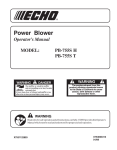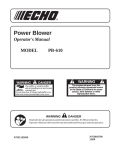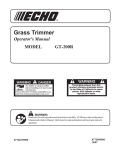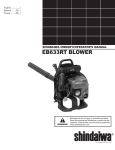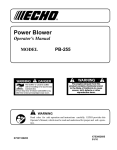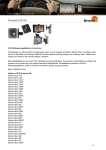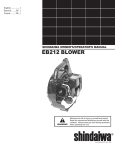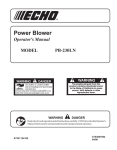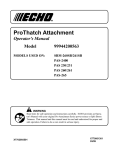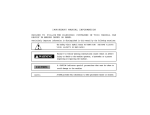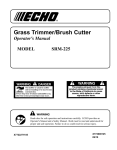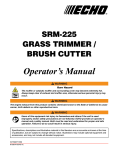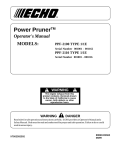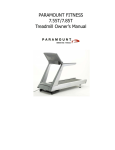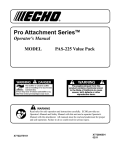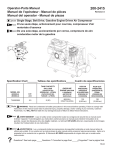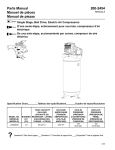Download Echo PB-755T User's Manual
Transcript
Power Blower Operator's Manual MODEL: PB-755H PB-755T WARNING Read rules for safe operation and all instructions carefully. ECHO provides this Operator's Manual which must be read and understood for proper and safe operation. X7531122402 X753002812 12/08 2 Introduction Welcome to the ECHO family. This ECHO product was designed and manufactured to provide long life and on-thejob-dependability. Read and understand this manual. You will find it easy to use and full of helpful operating tips and SAFETY messages. the operator's manual Read and understand this manual before operation. Keep it in a safe place for future reference. It contains specifications and information for operation, starting, stopping, maintenance, storage and assembly specific to this product. Table of Contents Introduction.................................................................2 - The Operator's Manual........................................2 Safety..........................................................................3 Manual Safety Symbols and Important Information..3 - International Symbols..........................................3 - Personal Condition and Safety Equipment..........3 - Equipment............................................................6 Emission Control........................................................6 Description..................................................................7 Contents ................................................................... 11 Assembly..................................................................12 - Install Blower Pipes / Stick Handle PB-755H... 12 - Install Blower Pipes PB-755T...........................13 Operation................................................................... 14 - Fuel.................................................................... 14 - Starting Cold Engine.......................................... 16 - Starting Warm Engine........................................ 17 - Stopping Engine................................................. 17 - Operating Blower...............................................18 Maintenance..............................................................19 - Skill Levels........................................................ 19 - Maintenance Intervals........................................ 19 - Air Filter............................................................ 20 - Fuel Filter...........................................................21 - Spark Plug..........................................................21 - Cooling System..................................................22 - Exhaust System..................................................23 - Carburetor Adjustment.......................................25 Troubleshooting........................................................26 Storage......................................................................27 Specifications............................................................28 Servicing Information...............................................32 - Parts/Serial Number ............................................32 - Service...............................................................32 - ECHO Consumer Product Support....................32 - Warranty Card....................................................32 - Additional or Replacement Manuals.................32 Specifications, descriptions and illustrative material in this literature are as accurate as known at the time of publication, but are subject to change without notice. Illustrations may include optional equipment and accessories, and may not include all standard equipment. CopyRight© 2008 By Echo, Incorporated All Rights Reserved. Power Blower Operator's Manual Safety manual safety symbols and important information Throughout this manual and on the product itself, you will find safety alerts and helpful, informational messages preceded by symbols or key words. The following is an explanation of those symbols and key words and what they mean to you. DANGER The safety alert symbol accompanied by the word “DANGER” calls attention to an act or condition which WILL lead to serious personal injury or death if not avoided. WARNING The safety alert symbol accompanied by the word “WARNING” calls attention to an act or condition which CAN lead to serious personal injury or death if not avoided. CAUTION The safety alert symbol accompanied by the word “CAUTION” calls attention to an act or condition which may lead to minor or moderate personal injury if not avoided. Circle and slash symbol This symbol means the specific action shown is prohibited. Ignoring these prohibitions can result in serious or fatal injury. NOTE This enclosed message provides tips for use, care and maintenance of the unit. IMPORTANT The enclosed message provides information necessary for the protection of the unit. international symbols Symbol form/shape Symbol description/application Symbol form/shape Read and understand Operator's Manual. Wear eyes, ears and head protection Hot Surface Safety/Alert DO NOT allow flames or sparks near fuel. Symbol description/application Symbol form/shape Fuel and oil mixture Finger Severing Wear hand protection. Use two handed. Wear slip resistant foot wear. Symbol description/application Emergency stop Symbol form/shape Symbol description/application Ignition ON/OFF Carburetoradjustment - Low speed mixture Primer bulb Carburetor adjustment - Idle speed Carburetor adjustment - High speed mixture Choke Control "Cold Start" Position (Choke Closed) Choke Control "Run" Position (Choke Open) DO NOT smoke near fuel. personal condition and safety equipment WARNING Power Blower users risk injury to themselves and others if the power blower is used improperly or safety precautions are not followed. Proper clothing and safety gear must be worn when operating a blower. 3 4 Physical Condition Your judgment and physical dexterity may not be good: • if you are tired or sick, • if you are taking medication, • if you have taken alcohol or drugs. Operate unit only if you are physically and mentally well. Eye Protection Wear eye protection that meets ANSI Z87.1 or CE requirements whenever you operate the unit. Hand Protection Wear no-slip, heavy-duty work gloves to improve your grip on the blower handle. Gloves also reduce the transmission of machine vibration to your hands. Breathing Protection Wear a facemask to protect against dust. Hearing Protection ECHO recommends wearing hearing protection whenever unit is used. Proper Clothing Wear snug fitting, durable clothing; • Pants should have long legs, shirts with long sleeves. • DO NOT WEAR SHORTS, • DO NOT WEAR TIES, SCARVES, and JEWELRY. Wear sturdy work shoes with nonskid soles: • DO NOT WEAR OPEN TOED SHOES, • DO NOT OPERATE UNIT BAREFOOTED. Keep long hair away from engine and blower intake. Retain hair with cap or net. Hot Humid Weather Heavy protective clothing can increase operator fatigue, which may lead to heat stroke. Schedule heavy work for early morning or late afternoon hours when temperatures are cooler. Vibration and Cold It is believed that a condition called Raynaud’s Phenomenon, which affects the fingers of certain individuals, may be brought about by exposure to vibration and cold. Exposure to vibration and cold may cause tingling and burning sensations, followed by loss of color and numbness in the fingers. The following precautions are strongly recommended, because the minimum exposure, which might trigger the ailment, is unknown. • Keep your body warm, especially the head, neck, feet, ankles, hands, and wrists. • Maintain good blood circulation by performing vigorous arm exercises during frequent work breaks, and also by not smoking. • Limit the hours of operation. Try to fill each day with jobs where operating the unit or other hand-held power equipment is not required. • If you experience discomfort, redness, and swelling of the fingers followed by whitening and loss of feeling, consult your physician before further exposing yourself to cold and vibration. Power Blower Operator's Manual Repetitive Stress Injuries It is believed that overusing the muscles and tendons of the fingers, hands, arms, and shoulders may cause soreness, swelling, numbness, weakness, and extreme pain in those areas. Certain repetitive hand activities may put you at a high risk for developing a Repetitive Stress Injury (RSI). An extreme RSI condition is Carpal Tunnel Syndrome (CTS), which could occur when your wrist swells and squeezes a vital nerve that runs through the area. Some believe that prolonged exposure to vibration may contribute to CTS. CTS can cause severe pain for months or even years. To reduce the risk of RSI/CTS, do the following: • Avoid using your wrist in a bent, extended, or twisted position. Instead try to maintain a straight wrist position. Also, when grasping, use your whole hand, not just the thumb and index finger. • Take periodic breaks to minimize repetition and rest your hands. • Reduce the speed and force with which you do the repetitive movement. • Do exercises to strengthen the hand and arm muscles. • Immediately stop using all power equipment and consult a doctor if you feel tingling, numbness, or pain in the fingers, hands, wrists, or arms. The sooner RSI/CTS is diagnosed, the more likely permanent nerve and muscle damage can be prevented. danger Do not operate this product indoors or in inadequately ventilated areas. Engine exhaust contains poisonous emissions and can cause serious injury or death. Read the Manuals • Provide all users of this equipment with the Operator’s Manual and Safety Manual for instructions on Safe Operation. Clear the Work Area • Spectators and fellow workers must be warned, and children and animals prevented from coming nearer than 15 m (50 ft.) while the unit is in use. • Take wind conditions into account: avoid open doors and windows. • Do not point blower at people or animals. Keep a Firm Grip • Hold the front and rear handles with both hands, with thumbs and fingers encircling the handles. Keep a Solid Stance • Maintain footing and balance at all times. Do not stand on slippery, uneven or unstable surfaces. Do not work in odd positions or on ladders. Do not over reach. Avoid Hot Surfaces • Keep exhaust area clear of flammable debris. Avoid contact during and immediately after operation. 5 6 equipment check WARNING Use only ECHO approved attachments. Serious injury may result from the use of a non-approved attachment combination. ECHO, INC. will not be responsible for the failure of cutting devices, attachments or accessories which have not been tested and approved by ECHO. Read and comply with all safety instructions listed in this manual and safety manual. • • • • Check unit for loose/missing nuts, bolts and screws. Tighten and/or replace as needed. Do not use blower if any part is missing or damaged. Have repairs done only by an authorized ECHO Service dealer. Do not use any attachment, accessory or replacement part unless it is recommended in this Operator's Manual. WARNING Moving parts can amputate fingers or cause severe injuries. Keep hands, clothing and loose objects away from all openings. •ALWAYS stop engine, disconnect spark plug, and make sure all moving parts have come to a complete stop before removing obstructions, clearing debris, or servicing unit. •DO NOT start or operate unit unless all guards and protective covers are properly assembled to unit. •NEVER reach into any opening while the engine is running. Moving parts may not be visible through openings. WARNINg Check fuel system for leaks due to fuel tank damage, especially if the unit is dropped. If damage or leaks are found, do not use unit, otherwise serious personal injury or property damage may occur. Have unit repaired by an authorized servicing dealer before using. Emission Control (exhaust & evaporative) EPA Phase 2 / C.A.R.B. TIER III The emission control system for the engine is EM/TWC (Engine Modification and 3-way Catalyst) and for the fuel tank the Control System is EVAP (Evaporative Emissions) or N (for nylon tank). Evaporative emission may be applicable to California models only. IMPORTANT ENGINE INFORMATION ENGINE FAMILY: 7EHXS.0635KB DISPLACEMENT: 63.3 cc EMISSION COMPLIANCE PERIOD : 300 HRS. THIS ENGINE MEETS U.S. EPA PH2 EXH AND 2007 AND LATER CALIFORNIA EXH AND EVAP EMISSION REGULATIONS FOR S.O.R.E. REFER TO OWNER'S MANUAL FOR MAINTENANCE SPECIFICATIONS AND ADJUSTMENTS. An Emission Control Label is located on the unit. (This is an EXAMPLE ONLY, information on label varies by engine FAMILY). PRODUCT EMISSION DURABILITY (EMISSION COMPLIANCE PERIOD) The 300 hour emission compliance period is the time span selected by the manufacturer certifying the engine emissions output meets applicable emissions regulations, provided that approved maintenance procedures are followed as listed in the Maintenance Section of this manual. Power Blower Operator's Manual Description PB-755H Locate these safety decals on your unit. Make sure the decals are legible and that you understand and follow the instructions on them. If a decal cannot be read, a new one can be ordered from your ECHO dealer. See PARTS ORDERING instructions for specific information. Hot Decal (near muffler) 1 11 2 3 P/N 89016006361 10 4 7 12 9 13 8 5 14 6 General Warning Decal (located on top of blower housing) P/N 89016009461 Sound Label (located on blower housing) dB(A) 74 Category III Measured at 50 ft. (15m) per ANSI B175.2 P/N X508000180 7 8 1. AIR CLEANER - Contains replaceable air filter element. 2. SPARK PLUG - Provides spark to ignite fuel mixture. 3. SAFETY DECAL - Lists important safety precautions. 4. SPARK ARRESTOR - CATALYTIC MUFFLER / MUFFLER - The muffler or catalytic muffler controls exhaust noise and emission. The spark arrestor screen prevents hot, glowing particles of carbon from leaving the muffler. Keep exhaust area clear of flammable debris. 5. CHOKE - Move lever up to "Cold Start" ( Run position ( ) starting position and for emergency stopping. Move lever down to ). 6. PURGE BULB - Pumping purge bulb before starting engine draws fresh fuel from the fuel tank, purging air from the carburetor. Pump purge bulb until fuel is visible and flows freely in the clear fuel tank return line. Pump purge bulb an additional 4 or 5 times. 7. RECOIL STARTER HANDLE - Pull recoil handle slowly until starter engages, then quickly and firmly. When engine starts, return handle slowly. DO NOT let handle snap back or damage to unit will occur. 8. FUEL TANK - Contains fuel and fuel filter. 9. FUEL TANK CAP - Covers and seals fuel tank. 10. HANDLE - Rotates downward for throttle control access. Spring loaded for flexible operation. 11. BLOWER PIPES - Exclusive positive locking system. 12. SHOULDER HARNESS - Used to support unit on operator's back. The straps are adjustable. 13. THROTTLE POSITION LEVER/STOP SWITCH - Combination stop switch and variable speed throttle lever. When the lever is moved all the way forward the blower is at Wide Open Throttle (W.O.T.). When the lever is moved rearward to detent, the blower is at idle. When the lever is moved rearward past the idle detent the blower will stop. 1 4. STICK HANDLE - Provides comfortable grip for directing air flow. Power Blower Operator's Manual PB-755T Locate these safety decals on your unit. Make sure the decals are legible and that you understand and follow the instructions on them. If a decal cannot be read, a new one can be ordered from your ECHO dealer. See PARTS ORDERING instructions for specific information. 1 Hot Decal (near muffler) 12 11 2 3 P/N 89016006361 4 10 5 13 9 8 6 14 15 7 16 17 General Warning Decal (located on top of blower housing) P/N 89016009461 Sound Label (located on blower housing) dB(A) 74 Category III Measured at 50 ft. (15m) per ANSI B175.2 P/N X508000180 9 10 1. AIR CLEANER - Contains replaceable air filter element. 2. SPARK PLUG - Provides spark to ignite fuel mixture. 3. SAFETY DECAL - Lists important safety precautions. 4. SPARK ARRESTOR - CATALYTIC MUFFLER / MUFFLER - The muffler or catalytic muffler controls exhaust noise and emission. The spark arrestor screen prevents hot, glowing particles of carbon from leaving the muffler. Keep exhaust area clear of flammable debris. 5. RECOIL STARTER HANDLE - Pull recoil handle slowly until starter engages, then quickly and firmly. When engine starts, return handle slowly. DO NOT let handle snap back or damage to unit will occur. 6. CHOKE - Move lever up to "Cold Start" ( Run position ( ) starting position and for emergency stopping. Move lever down to ). 7. PURGE BULB - Pumping purge bulb before starting engine draws fresh fuel from the fuel tank, purging air from the carburetor. Pump purge bulb until fuel is visible and flows freely in the clear fuel tank return line. Pump purge bulb an additional 4 or 5 times. 8. FUEL TANK - Contains fuel and fuel filter. 9. FUEL TANK CAP - Covers and seals fuel tank. 10. BLOWER PIPES - Exclusive positive locking system. 11. THROTTLE POSITION LEVER - Pull back to increase engine speed. Friction washers maintain throttle lever setting. 12. STOP SWITCH - Slide switch mounted on top of handle. Move forward to run, back to stop. 13. SHOULDER HARNESS - Used to support unit on operator's back. The straps are adjustable. 14. HANDLE - Used by operator to direct and control air flow. 15. THROTTLE TRIGGER - Spring loaded to return to idle when released. During acceleration, press trigger gradually for best operating technique. 16. LOCKING KNOB - Allows operator to adjust handle position for optimum comfort and control. 17. FLEXIBLE PIPE - Allows for full range of movement. Power Blower Operator's Manual Contents PB-755H ___ ___ ___ ___ ___ ___ ___ ___ ___ ___ ___ ___ ___ ___ ___ 1 - Power Head 1 - Flex Pipe 1 - Pipe w/swivel 1 - Straight Pipe 1 - Straight Pipe 1 - Operator's Manual 1 - Warranty Registration Card 1 - ECHO Emissions and Warranty Statement 1 - Plastic Bag 2 - Clamps w/screws 1 - Stick Handle 1 - Bolt 6x45 1 - Washer 6 1 - Wing nut 1 - Echo Power Blend X TM 2-stroke oil sample PB-755T ___ ___ ___ ___ ___ ___ ___ ___ ___ ___ ___ ___ 1 - Power Head 1 - Flex Pipe 1 - Pipe w/swivel 1 - Straight Pipe 1 - Straight Pipe 1 - Operator's Manual 1 - Warranty Registration Card 1 - ECHO Emissions and Warranty Statement 1 - Plastic Bag 2 - Clamps w/screws 1 - Guide Loop 1 - Echo Power Blend X TM 2-stroke oil sample 11 12 Assembly PB-755H WARNING Never perform maintenance or assembly procedures with engine running or serious personal injury may result. install blower pipes / stick handle 1. Assemble clamps (A) onto both ends of flexible pipe (B). A A B 2. Assemble swivel pipe (C) into flexible pipe (B) and tighten clamp (A). B 3. Assemble flexible pipe (B) to elbow (D) on blower and tighten clamp (A). NOTE A light lubricant may be used to ease assembly of flexible pipe to blower elbow. C D 4. Loosen wing nut (E) completely and open stick handle clamp. G H 5. Align notches (F) in handle clamp with tabs (G). F 6. Slide stick handle onto swivel pipe (C). Stick handle should be angled away from operator. E 7. Position stick handle (H) for comfortable operation, and tighten wing nut (E). 8. Assemble straight pipe (I) onto swivel pipe (C), until you feel light resistance. Do not force connection. Hold swivel pipe and turn straight pipe clockwise, engaging positive locking channels, until connection is firm. Do not force connection. G C I 9. Assemble straight pipe with decal (J) to straight pipe (I) as in step 8. NOTE Blower use will eventually loosen pipe connections. Exclusive positive locking system allows pipes to be tightened. If loosening occurs, remove two straight pipes and install according to instructions 8 & 9. J Power Blower Operator's Manual 13 PB-755T G G WARNING Never perform maintenance or assembly procedures with engine running or serious personal injury may result. install blower pipes B G A A 1. Place guide loop (G) across elbow clamp, and turn until clips fully engage clamp band. 2. Assemble clamps (A) onto both ends of flexible pipe (B). NOTE Clamp with cable guide loop (G) fits elbow end of flexible pipe. 3. Assemble swivel pipe (C) into flexible pipe (B). B E F NOTE Assure throttle cable is not twisted before installing handle (E). D C H 4. Position cable between the elbow (D) and frame and along the top of the flexible pipe. Loosen knob (H) on handle (E). Align notch in handle with tabs (F). Install onto swivel pipe (C) past long ridges in pipe. 5. Assemble flexible pipe (B) to elbow (D) on blower and tighten clamps (A). Position guide loop (G) on inside (blower side) of flexible tube. G E NOTE A light lubricant may be used to ease assembly of flexible pipe to blower elbow. H 6. Clip throttle cable into throttle cable guide loop (G). 7. Move handle (E) to desired position. Tighten knob (H) hand tight. 8. Assemble straight pipe (I) onto swivel pipe (C), until you feel light resistance. Do not force connection. Hold swivel pipe and turn straight pipe clockwise, engaging positive locking channels, until connection is firm. Do not force connection. 9. Assemble straight pipe with decal (J) to straight pipe (I) as in step 8. NOTE Blower use will eventually loosen pipe connections. Exclusive positive locking system allows pipes to be tightened. If loosening occurs, remove two straight pipes and install according to instructions 8 & 9. J E I C 14 Operation WARNING Moving parts can amputate fingers or cause severe injuries. Keep hands, clothing and loose objects away from all openings. Always stop engine, disconnect spark plug, and make sure all moving parts have come to a complete stop before removing obstructions, clearing debris, or servicing unit. Blower housing may contain shredder blades and other sharp edges that can cause serious injuries if touched, even if engine is off and blades are not moving. Wear gloves to protect hands from sharp edges and hot surfaces. fuel NOTICE: Use of unmixed, improperly mixed, or fuel older than 90 days, (stale fuel), may cause hard starting, poor performance, or severe engine damage and void the product warranty. Read and follow instructions in the Storage section of this manual. WARNING Alternative fuels, such as E-20 (20% ethanol), E-85 (85% ethanol) or any fuels not meeting ECHO requirements are NOT approved for use in ECHO 2-stroke gasoline engines. Use of alternative fuels may cause performance problems, loss of power, overheating, fuel vapor lock, and unintended machine operation, including, but not limited to, improper clutch engagement. Alternative fuels may also cause premature deterioration of fuel lines, gaskets, carburetors and other engine components. Fuel Requirements Gasoline - Use 89 Octane [R+M/2] (mid grade or higher) gasoline known to be good quality. Gasoline may contain up to 10% Ethanol (grain alcohol) or 15% MTBE (methyl tertiary-butyl ether). Gasoline containing methanol (wood alcohol) is NOT approved. Two Stroke Oil - A two-stroke engine oil meeting ISO-L-EGD (ISO/CD 13738) and JASO M345/FC/FD Standards must be used. ECHO brand premium Power Blend X TM Universal 2-Stroke Oil meets these standards. Engine problems due to inadequate lubrication caused by failure to use an ISO-L-EGD (ISO/CD 13738) and JASO M345/FC/FD certified oil, such as ECHO premium Power Blend X TM, will void the two-stroke engine warranty. IMPORTANT Echo premium Power Blend X TM Universal 2-Stroke Oil may be mixed at 50:1 ratio for application in all Echo engines sold in the past regardless of ratio specified in those manuals. Power Blower Operator's Manual Handling Fuel DANGER Fuel is VERY flammable. Use extreme care when mixing, storing or handling or serious personal injury may result. •Use an approved fuel container. •DO NOT smoke near fuel. •DO NOT allow flames or sparks near fuel. •Fuel tanks/cans may be under pressure. Always loosen fuel caps slowly allowing pressure to equalize. •NEVER refuel a unit when the engine is HOT or RUNNING! •DO NOT fill fuel tanks indoors. ALWAYS fill fuel tanks outdoors over bare ground. • DO NOT overfill fuel tank. Wipe up spills immediately. •Securely tighten fuel tank cap and close fuel container after refueling. •Inspect for fuel leakage. If fuel leakage is found, do not start or operate unit until leakage is repaired. •Move at least 3m (10 ft.) from refueling location before starting the engine. Mixing Instructions 1. Fill an approved fuel container with half of the required amount of gasoline. 2. Add the proper amount of 2-stroke oil to gasoline. 3. Close container and shake to mix oil with gasoline. 4. Add remaining gasoline, close fuel container, and remix. IMPORTANT Spilled fuel is a leading cause of hydrocarbon emissions. Some states may require the use of automatic fuel shut-off containers to reduce fuel spillage. After use • DO NOT store a unit with fuel in its tank. Leaks can occur. Return unused fuel to an approved fuel storage container. Storage - Fuel storage laws vary by locality. Contact your local government for the laws affecting your area. As a precaution, store fuel in an approved, airtight container. Store in a well-ventilated, unoccupied building, away from sparks and flames. IMPORTANT Stored fuel ages. Do not mix more fuel than you expect to use in thirty (30) days, ninety (90) days when a fuel stabilizer is added. IMPORTANT Stored two-stroke fuel may separate. ALWAYS shake fuel container thoroughly before each use. 15 16 starting cold engine • Recoil starter: Use short pulls - only 1/2-2/3 of rope length for starting. Do not allow the rope to snap back in. Always hold the unit firmly. PB-755H PB-755H A 1. Throttle Lever Move throttle lever (A) to IDLE DETENT position. PB-755T 1. Throttle Lever/Stop Switch Move throttle lever (A) forward to idle position. Slide stop switch (B) forward to run position. PB-755T PB-755H, PB-755T 2. Choke Move choke (C) up to "Cold Start" position ( ). 3. Purge Bulb Pump purge bulb (D) until fuel is visible and flows freely in the clear fuel tank return line. Pump bulb an additional 4 or 5 times. C 4. Recoil Starter Pull recoil starter handle (E) until engine fires (5 or 6 pulls maximum). D 5. Choke Move choke (C) down to run position ( restart engine. ), and if necessary, NOTE If engine does not start after 5 pulls, move choke to "Cold Start" position, and repeat steps 4 & 5. NOTE Allow engine to warm up before use. B A C E Power Blower Operator's Manual starting warm engine PB-755H PB-755H A 1. Throttle Lever Move throttle lever (A) to IDLE DETENT position. PB-755T 1. Throttle Lever/Stop Switch Move throttle lever (A) forward to idle position. Slide stop switch (B) forward to run position. PB-755T B A PB-755H, PB-755T 2. Recoil Starter Pull recoil starter handle (E) and engine should start. Do not use choke (C). NOTE If engine does not start after 5 pulls, use cold start procedures. C E stopping engine PB-755H 1. Throttle Lever Move throttle lever (A) to idle detent position and allow engine to return to idle before shutting off engine. 2. Move throttle lever (A) to "O" (Stop) position. A PB-755H PB-755T 1. Throttle Trigger/Throttle Position Lever Release throttle trigger (C). Move throttle position lever (A) forward to idle position and allow engine to return to idle before shutting engine off. 2. Stop Switch Slide stop switch (B) to Stop position. B PB-755T A WARNING If engine does not stop when stop switch is moved to STOP position, close choke - COLD START position - to stall engine. Have your ECHO dealer repair stop switch before using blower again. C 17 18 operating blower WARNING Engine exhaust IS HOT, and contains Carbon Monoxide (CO), a poison gas. Breathing CO can cause unconsciousness, serious injury, or death. Exhaust can cause serious burns. ALWAYS blow exhaust away from your face and body. WARNING Always wear safety glasses, hearing protection, a face filter mask and take all safety precautions or serious personal injury may result. Do not point the blower pipe in the direction of people or pets. Read the Safety Section on pages 4 - 6 carefully. PB-755H IMPORTANT To avoid engine damage due to over-revving, do not block blower pipe opening. 1. Use only during appropriate hours. 2. Allow the engine to warm up at a fast idle for a few minutes. 3. PB-755H Set engine speed with throttle lever (A). PB-755T Control engine speed with throttle trigger (C), or throttle position lever (A). Rotate throttle position lever forward for lower speed, back for higher speed. 4. Use lower speed to blow dry leaves from walks, patios and drives. 5. Additional speed may be necessary to clean grass and leaves from a lawn or flower bed. 6. Higher speed may be necessary to move gravel, dirt, snow, bottles or cans from a driveway, street, parking lot or stadium. NOTE Never use a higher speed setting than necessary to perform a task. Remember, the higher the engine speed, the louder the blower noise. Minimize dust by using blower at lower speeds and by dampening material with water/mist when necessary. Keep debris on your property. Be Smart - be a good neighbor. PB-755T A C A Power Blower Operator's Manual 19 Maintenance WARNING Moving parts can amputate fingers or cause severe injuries. Keep hands, clothing and loose objects away from all openings. Always stop engine, disconnect spark plug, and make sure all moving parts have come to a complete stop before removing obstructions, clearing debris, or servicing unit. Allow unit to cool before performing service. Wear gloves to protect hands from sharp edges and hot surfaces. Your ECHO blower is designed to provide many hours of trouble free service. Regular scheduled maintenance will help your blower achieve that goal. If you are unsure or are not equipped with the necessary tools, you may want to take your unit to an ECHO Service Dealer for maintenance. To help you decide whether you want to DO-IT-YOURSELF or have the ECHO Dealer do it, each maintenance task has been graded. If task is not listed, see your ECHO Dealer for repairs. skill level Level 1 = Level 2 = Easy to do. Common tools may be required. Moderate difficulty. Some specialized tools may be required. ECHO offers REPOWERTM Maintenance Kits and Parts to make your maintenance job easier. maintenance intervals COMPONENT / SYSTEM MAINTENANCE PROCEDURE REQ'D SKILL LEVEL DAILY OR BEFORE USE EVERY REFUEL 3 MONTHS YEARLY OR 90 600 HOURS HOURS Air Filter Inspect/Clean 1 I/C* Choke Shutter Inspect/Clean 1 I/C Fuel Filter Inspect/Replace 1 I * Fuel Cap Gasket Inspect/Replace 1 I * Fuel System Inspect/Replace 1 Spark Plug Inspect/Clean/Replace 1 Cooling System Inspect/Clean 2 Muffler Spark Arrestor Inspect/Clean/Replace 2 I/C/R* Cylinder Exhaust Port Inspect/Clean/Decarbon 2 I/C Recoil Starter Rope Inspect/Clean 1 I/C* Screws/Nuts/Bolts Inspect/Tighten/Replace 1 I * I (1) * R* I/R* I (1) * I/C/R* I/C MAINTENANCE PROCEDURE LETTER CODES: I = INSPECT, R = REPLACE, C = CLEAN IMPORTANT NOTE - Time intervals shown are maximum. Actual use and your experience will determine the frequency of required maintenance. MAINTENANCE PROCEDURE NOTES: (1) Low evaporative fuel tanks DO NOT require regular maintenance to maintain emission integrity. * All recommendations to replace are based on the finding of damage or wear during inspection. 20 air filter Level 1. Tools required: 25 - 50mm (1 - 2 in.) cleaning brush Parts required: Tune Up Kit NOTE Always brush dirt and debris away from air cleaner area prior to cleaning air filter. 1. Brush dirt off air cleaner area. Keep dirt away from engine and air intake grid. 2. Remove air filter cover. Brush dirt from inside cover and away from edges of air filter. 3. Check air filter seal for tight fit with air filter case. 4. Remove air filter from case. Use care to prevent dirt and debris from falling into air filter case. 5. Inspect filter element and seal. Replace filter if any of these problems are present: •Air filter seal does not fit tightly against case •Air filter seal is distorted, worn, or damaged •Air filter element has holes or other damage •Air filter element is saturated with dirt •Air filter element is soaked with fuel mix 6. If air filter is in good condition and can be cleaned and reused, lightly brush debris from air filter element, or blow filter element clean using low pressure (40 psi or less) compressed air directed at inside of filter. IMPORTANT When using compressed air, always direct air stream at inside surface of filter so dust and debris will be blown out of filter. Keep air nozzle 6 - 8 inches away from filter to prevent damage to filter. 7. Install air filter in case, and replace cover. NOTICE Actual replacement interval for air filter depends on operating conditions. Operation in dustier applications requires more frequent cleaning and replacement. Continued operation with a damaged or excessively dirty filter will allow dirt and debris to enter engine, and result in poor performance, rapid engine wear, and premature engine failure. Power Blower Operator's Manual fuel filter Level 1. Tools required: 200 - 250 mm (8 - 10 in.) length of wire with one end bent into a hook, clean rag, funnel, and an approved fuel container Parts required: RepowerTM Tune Up Kit DANGER Fuel is VERY flammable. Use extreme care when mixing, storing or handling. 1. Use a clean rag to remove loose dirt from around fuel cap and empty fuel tank. 2. Use the “fuel line hook” to pull the fuel line and filter from the tank. 3. Remove the filter from the line and install the new filter. spark plug Level 1. Tools required: 19mm Spark Plug deep socket, Feeler gauge Parts Required: RepowerTM Tune Up Kit IMPORTANT Use only NGK BPM-8Y spark plug (BPMR-8Y in Canada) otherwise severe engine damage may occur. 1. Remove spark plug , and check for fouling, worn and rounded center electrode. 2. Clean the plug or replace with a new one. DO NOT sand blast to clean. Remaining sand will damage engine. 3. Adjust spark plug gap by bending outer electrode. 4. Tighten spark plug to 150-170 kgf • cm (130-150 in • lbf). 0.65 mm (0.026 in.) 21 22 cooling system Level 2. Tools required: 25 - 50mm (1 - 2 in.) cleaning brush, Cross Head Screwdriver Parts Required: None, if you are careful. I MPORTANT To maintain proper engine operating temperatures, cooling air must pass freely through the cylinder fin area. This flow of air carries combustion heat away from the engine. Overheating and engine seizure can occur when: • Air intakes are blocked, preventing cooling air from reaching the cylinder. • Dust and grass build up on the outside of the cylinder. This build up insulates the engine and prevents the heat from leaving. Removal of cooling passage blockages or cleaning of cooling fins is considered “Normal Maintenance.” Any failure attributed to lack of maintenance is not warranted. Cleaning Grill 1. Remove accumulated debris from intake grill between backpack frame and blower housing. Cleaning Cylinder Fins 1. Remove spark plug and engine cover (four screws), pull cover away from engine. 2. Clean cylinder fins (A) to allow cooling air to pass freely. 3. Install engine cover and spark plug. A Power Blower Operator's Manual 23 exhaust system Spark Arrestor Screen Level 2. Tools required: Cross Head Screwdriver Parts Required: Spark arrestor screen, Gaskets WARNING Do not perform maintenance on engine or muffler until engine and muffler are completely cool, otherwise serious personal injury may result. IMPORTANT Carbon deposits in muffler will cause a drop in engine output and overheating. Spark arrestor screen must be checked periodically. 1. Remove spark plug and engine cover (four screws). 2. Remove spark arrestor covers (A), gaskets (B), and spark arrestor screen (C) from muffler. Replace screen if plugged with carbon deposits. NOTE When cleaning carbon deposit, be careful not to damage the catalytic element inside muffler. 3. Install spark arrestor screen and cover. 4. Install spark plug and engine cover. C B A 24 Exhaust Port Cleaning Level 2 Tools required: Wood or plastic scraper, Cross Head Screwdriver, 4 & 5mm Hex Wrench Parts Required: As needed: Muffler gasket 1. Remove spark plug lead from spark plug, and remove engine cover (5 screws). 2. Place piston at top dead center. Remove muffler (A) and muffler gasket (B ). 3. Use a wood or plastic scraping tool to clean deposits from cylinder exhaust port. IMPORTANT Never use a metal tool to scrape carbon from the exhaust port. Do not scratch the cylinder or piston when cleaning the exhaust port. Do not allow carbon particles to enter the cylinder. 4. Inspect muffler gasket, and replace if damaged. 5. Install muffler gasket and muffler. 6. Tighten muffler mounting bolts (or nuts) to 80-95 in•lbf (90-110 kgf•cm). 7. Start engine, and warm to operating temperature. 8. Stop engine, and re-tighten mounting bolts (or nuts) to specifications. 9. Install engine cover and attach spark plug lead. Power Blower Operator's Manual carburetor adjustment Engine Break-In New engines must be operated a minimum duration of two tanks of fuel break-in before carburetor adjustments can be made. During the breakin period your engine performance will increase and exhaust emissions will stabilize. Idle speed can be adjusted as required. High Altitude Operation This engine has been factory adjusted to maintain satisfactory starting, emission, and durability performance up to 1,100 feet mean sea level (MSL) (96.0 kPa and below). To maintain proper engine operation and emission compliance above 1,100 feet MSL the carburetor may need to be adjusted by an authorized ECHO service dealer. Important If the engine is adjusted for operation above 1,100 feet MSL, the carburetor must be re-adjusted when operating the engine below 1,100 feet MSL, otherwise severe engine damage can result. Level 2. Tools required: Screwdriver, tachometer (Echo P/N 99051130017) Parts required: None. NOTE Do not adjust carburetor unless necessary. If you have difficulty, see your ECHO dealer. Before Adjustment Check that: • Air filter is clean and properly installed. • Spark arrestor screen is free of carbon. • Blower pipes are installed. 1. Start engine, run at idle for one minute. 2. Complete warm up by running at full throttle for 5 minutes, operating choke twice to clear air from carburetor chambers. 3. Check idle speed and reset if necessary. If a tachometer is available, idle speed screw (A) should be set to the specifications found on Page 28 "Specifications" of this manual. Turn idle screw (A) clockwise to increase idle speed; counter clockwise to decrease idle speed. 4. Use a tachometer to adjust idle speed to specifications found on page 28. A 25 26 Troubleshooting TROUBleSHOOTING CHART Problem Engine cranks starts hard/ doesn't start C h eck Status Fuel at carburetor No fuel at carburetor Fuel at cylinder C au se Remedy Fuel strainer clogged Fuel line clogged Carburetor Clean or replace Clean or replace See your Echo dealer No fuel at cylinder Carburetor See your Echo dealer Muffler wet with fuel Fuel Mixture too rich Open choke Clean/replace air filter Adjust carburetor See your Echo dealer Spark at end of plug wire No spark Stop switch off Electrical problem Interlock switch Turn switch to ON See your Echo dealer See your Echo dealer Spark at plug No spark Spark gap incorrect Covered with carbon Fouled with fuel Plug defective Adjust to .65mm (0.026 in.) Clean or replace Clean or replace Replace plug Air filter Air filter dirty Normal wear Clean or replace Fuel filter Fuel filter dirty Contaminants/residues in fuel Replace Fuel vent Fuel vent plugged Spark Plug Plug dirty/worn Carburetor Improper adjustment Cooling System Cooling system dirty/plugged Spark Arrestor Screen Spark arrestor screen plugged Engine does not crank N/A N/A Engine runs, blower doesn't work or is weak/uneven Blower pipe Pipe clogged Engine runs, but dies or does not accelerate properly DANGER Pipe loose Pipe damaged Contaminants/residues in fuel Clean or replace Normal wear Clean and adjust or replace Vibration Adjust Extended operation in dirty/dusty locations Clean Normal wear Replace Internal engine problem See your Echo dealer Build-up of debris Unclog Vibration Tighten Wear/Misuse Replace Fuel vapors are extremely flammable and may cause fire and/or explosion. Never test for ignition spark by grounding spark plug near cylinder plug hole, otherwise serious personal injury may result. Power Blower Operator's Manual Storage warning During operation the muffler or catalytic muffler and surrounding cover become hot. Always keep exhaust area clear of flammable debris during transportation or when storing, otherwise serious property damage or personal injury may result. Long Term Storage (Over 30 Days) Do not store your unit for a prolonged period of time (30 days or longer) without performing protective storage maintenance which includes the following: 1. Store unit in a dry, dust free place, out of the reach of children. DANGER Do not store in enclosure where fuel fumes may accumulate or reach an open flame or spark. 2. Place the stop switch in the "STOP" position. 3. Remove accumulation of grease, oil, dirt and debris from exterior of unit. 4. Perform all periodic lubrication and services that are required. 5. Tighten all screws and nuts. 6. Drain the fuel tank completely and pull the recoil starter handle several times to remove fuel from the carburetor. 7. Remove the spark plug and pour 7cc (1/4 oz.) of fresh, clean ECHO 2-stroke engine oil into the cylinder through the spark plug hole. A.Place a clean cloth over the spark plug hole. B.Pull the recoil starter handle 2-3 times to distribute the oil inside the engine. C.Observe the piston location through the spark plug hole. Pull the recoil handle slowly until the piston reaches the top of its travel and leave it there. 8. Install the spark plug (do not connect ignition cable). 9. Remove blower pipe assembly from unit. 27 28 Specifications MODEL���������������������������������������������������� PB-755H, PB-755T Length ������������������������������������������������������ 375 mm (14.8 in.) Width�������������������������������������������������������� 485 mm (19 in.) Height������������������������������������������������������� 527 mm (20.8 in.) Weight (dry) (PB-755H)��������������������������������� 11.8 kg (26.2 lb.) Weight (dry) (PB-755T)���������������������������������� 11.8 kg (26.2 lb.) Engine Type������������������������������������������������ Air cooled, two-stroke, single cylinder gasoline engine Displacement����������������������������������������������� 63.3 cc (3.86 cu. in.) Bore���������������������������������������������������������� 48.0 mm (1.89 in.) Stroke�������������������������������������������������������� 35.0 mm (1.38 in.) Carburetor�������������������������������������������������� Walbro w/primer bulb Ignition System�������������������������������������������� Flywheel Magneto, capacitor discharge ignition type Spark Plug�������������������������������������������������� NGK BPM-8Y Gap 0.65 mm (0.026 in.) Exhaust System�������������������������������������������� Spark Arrestor - Catalytic Muffler / Muffler Fuel���������������������������������������������������������� Mixed (Gasoline and Two-stroke Oil) Fuel/Oil Ratio���������������������������������������������� 50 : 1 Power Blend X TM ISO-L-EGD (ISO/CD 13738) and J.A.S.O. M345- FC/FD, two-stroke, air-cooled engine oil. Gasoline����������������������������������������������������� Use 89 Octane unleaded. Do not use fuel containing methyl alcohol, more than 10% ethyl alcohol or 15% MTBE. Do not use alternative fuels such as E-20 or E-85. Oil������������������������������������������������������������ Power Blend X TM Premium Universal 2-Stroke Oil Fuel Tank Capacity���������������������������������������� 2.0 lit. (67.7 US fl. oz.) Recoil Starter System������������������������������������� Automatic Recoil Starter Centrifugal Type Idle Speed �������������������������������������������������� 2400 - 3200 (RPM) Wide Open Throttle Speed ������������������������������� 6800 - 7300 (RPM) Maximum Air Speed (Measured at pipe end)��������� 329.9 KM/H (205 mph) Average Air Volume (Measured at pipe end)���������� 17.6 m3/min. (620 cu. ft./min.) Sound Level at 50 ft. dB(A) scale per ANSI B175.2� 74 dB(A) Power Blower Operator's Manual notes 29 30 notes Power Blower Operator's Manual notes 31 Servicing Information parts/serial number Genuine ECHO Parts and ECHO REPOWER™ Parts and Assemblies for your ECHO products are available only from an Authorized ECHO Dealer. When you do need to buy parts always have the Model Number, Type and Serial Number of the unit with you. You can find these numbers on the engine housing. For future reference, write them in the space provided below. Model No. _____________ Type _________SN. ______________ service DEALER? Call 1-800-432-ECHO Service of this product during the warranty period must be performed by an Authorized ECHO Service Dealer. For the name and address of the Authorized ECHO Service Dealer nearest you, ask your retailer or call: 1-800-432-ECHO (3246). Dealer information is also available on our Web Site. When presenting your unit for Warranty service/repairs, proof of purchase is required. 1-800-432-3246 or www.echo-usa.com echo consumer product support If you require assistance or have questions concerning the application, operation or maintenance of this product you may call the ECHO Consumer Product Support Department at 1-800-673-1558 from 8:30 am to 4:30 pm (Central Standard Time) Monday through Friday. Before calling, please know the model and serial number of your unit to help your Consumer Product Support Representative. CONSUMER PRODUCT SUPPORT 1-800-673-1558 8:30 - 4:30 Mon - Fri C.S.T. warranty registration To ensure trouble free warranty coverage it is important that you register your Echo equipment on-line at www.echo-usa.com. Other registration options are by automated phone at 1-800-432-3246 or by filling out the warranty registration card supplied with your unit. Registering your product confirms your warranty coverage and provides a direct link between you and ECHO if we find it necessary to contact you. additional or replacement manuals Safety Manuals in English/Spanish or English/French are available, free of charge, from your ECHO dealer or at www. echo-usa.com. Operator's and Parts Manuals are available by: • Downloading free from www.echo-usa.com • Purchasing from your Echo Dealer. • Manuals are available by sending a written request stating the model number and serial number of your Echo unit, part number of the manual, your name and address, and mail to the address below. Safety Videos are available from your Echo dealer. A $5.00 shipping charge will be required for each video. ECHO, INCORPORATED (H) P08511001001/P08511999999 (H) P10012001001/P10012999999 400 Oakwood Road Lake Zurich, IL 60047 www.echo-usa.com (T) P08611001001/P08611999999 (T) P10812001001/P10812999999
































